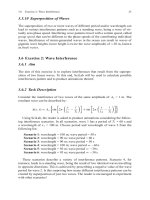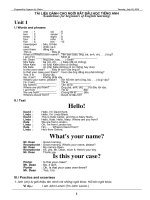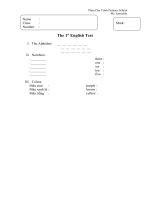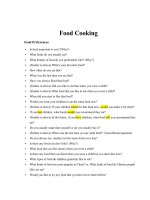Candle Making Craft For Beginners pdf
Bạn đang xem bản rút gọn của tài liệu. Xem và tải ngay bản đầy đủ của tài liệu tại đây (534.07 KB, 27 trang )
Candle Making Craft For Beginners
by Kaye Dennan
For MORE EBOOKS by Kaye Dennan visit:
/>
Table of Contents
1. Contents
2. Introduction
3. Equipment You Need For Candle Making
4. Tips To Be Aware Of For Better Candle Making
5. Candle Making Safety
6. Candle Making Projects - Two Colored Pillar Candle
7. Candle Making Projects - Votive Candles
8. Candle Making Projects - Marble Candles
9. Candle Making Projects - Ice Candles
10. Candle Making Projects - Innovative Candle Ideas
1. CONTENTS
Introduction
Equipment You Need for Candle Making
Tips to be Aware of for Better Candle Making
Candle Making Safety
Making Your Own Candles
- Two Colored Pillar Candle
- Votive Candles
- Marble Candles
- Ice Candles
- Innovative Candle Ideas
2. INTRODUCTION
The Beginners Guide
Are you starting a new and exciting hobby? Or even hoping to start a money making venture? Either
way it is a really wonderfully artistic hobby. It is one where you can let your imagination go wild.
Although candle making is relatively easy to do, it is really important to read our Candle Making
Safety section before you start so that you are set up correctly and have the right safety equipment
on hand.
When you have experimented from this book you might like to visit two other sites for candle making:
Start Candle Making - />The ebook in this site is very in-depth and suits a person who wants to make a lot of different types of
candles and spend quite a bit of money on this hobby.
Candle Making Biz - />This site also has a more in-depth book on candle making plus it has a mini-course about candle
making as a business and also a bonus ebook on running a business.
3. EQUIPMENT YOU NEED FOR CANDLE MAKING
The following are the items you will need to do candle making:
1. Melting Pot
2. Thermometer
3. Pour Pot
4. Scale to weigh your wax
5. Hammer to break up wax
6. Wire whisk
7. Heat proof gloves and pliers
8. Molds
9. Glue Gun
10. Popsicle sticks
Let me describe these:
1. MELTING POT
The use of a double boiler is a popular method of melting wax – a little slower but by far the safest.
As you get more experience you can look at other methods, but not directly on the stove top until you
really know what you are doing and only for certain types of wax.
2. THERMOMETER
You need a good numerical thermometer and you need to use this in conjunction with any type of
melting pot.
3. POUR POT
These come in all shapes and sizes but preference should be given to an aluminium “candle makers”
pour pot or to a pyrex jug.
4. SCALES
For the hobby candle maker you would probably be starting off with about 4 lbs of wax whilst you
are learning. Make sure the scales are nice solid ones not flimsy ones.
5. HAMMER
This is simply used to break the wax up into chunks to be able to weigh it and also put it in the double
boiler.
6. WIRE WISK
Used for blending fragrances and mixing in dyes.
7. GLOVES and PLIERS
Handle ALL hot containers with gloves on or with pliers. Depending on what you are using you may
need heat proof gloves or otherwise cotton gloves will do for warm items.
8. MOLDS
Depending on what candles you are going to make you will need to acquire molds.
9. GLUE GUN
For gluing in wick pins on certain molds. Sometimes you can secure the wicks with blue tac.
10. POPSICLE STICKS OR SIMILAR
Popsicle sticks or flat sided pencils are used to hold the wicks in place on certain molds.
SUPPLIES TO MAKE YOUR CANDLES
Now you are ready to purchase your candle making supplies.
You will need the following supplies:
1. Candle Wax – check with your supplier which wax will suit your chosen candle style
2. Wax coloring or dye – comes in beads or liquid
3. Fragrance Oil
4. Wicks and wick pins
Some more information to help you:
1. CANDLE WAX
You will need candle wax. To start with, you will probably do batches of about 4 lbs at a time.
There are many types of wax available and you will need to read up on these depending on the job
you want to do. BUT I would suggest even at the beginning don’t use cheap and nasty wax because
you will think you are doing something wrong when in fact it may only be your choice of wax causing
the problem.
2. WAX COLORING AND DYES
Candle wax dyes are easily available and using when concentrates they do last a long time and give
good color. Not only that, if you use inferior coloring methods, you may find that the candle does not
burn as efficiently as it should.
3. FRAGRANCE OIL
There are many of these on the market and it is only by shopping around and experimenting that you
will know what suits your purposes best. Concentrates give the best fragrance and longest fragrance
but there are also diluted oils around and you can decide what is best for you. BUT again think this
through carefully. If you are going to sell fragrant candles and wish for return sales you should use
the best available.
4. WICKS
This is one area that you do have to do some experimentation. You will be looking for a good burn
and scent throw. Using different sizes of wick will give a different result. You will also need wick
pins to suit. Your supplier should be able to help you with this when you explain the project you are
going to do.
4. TIPS TO BE AWARE OF FOR BETTER CANDLE MAKING
Work area
Prepare your work area and keep it clean with plenty of room to move around. Make sure ALL your
candle making needs are within reach. ESPECIALLY the chemical fire extinguisher
Preparing the molds
Prepare your molds before you start melting your wax. Make sure they are clean with wicks in place
and ready for heating before you pour. Warm molds will prevent you from having ‘pour marks’ down
the side of your molds.
Glass molds MUST be heated before being poured into. Place your cold glassware on a tray and put
in the oven - heat to approximately 150 degrees.
UV lighting
Check with your supplier about the wax you use because you don’t want your candles fading. You
may need to add a UV Inhibitor.
Second pour
To prevent a dip in the top of your candles you will need to top up your candles (do a second pour)
when your wax in the mold is cool to touch. Heat the wax (making sure to give it a couple of minutes
good stirring) to approximately 10 degrees hotter than your first pour, then top up your candles. If you
have left your candles to get cool enough the top should remain nice and flat. But if you do a second
pour when the original wax was still too warm the completed candle will have a nipple effect at the
top.
It is important that when using colored wax that the second pour is done with some of the original
wax or the color may not match.
Wicks
It is possible to buy pre-tabbed and pre-waxed wicks, but it is up to you what you buy. Wicks are a
very important part of candle making because of the burn factor. You will need to research this,
especially if you are making more novelty candles. You will get plenty of help from a good supplier.
Flat Candle Base
If the base of your candle is not flat simply place it on a hot pan surface and melt it down so that it is
flat.
5. CANDLE MAKING SAFETY
READ THESE SAFETY INSTRUCTIONS BEFORE YOU START CANDLE MAKING
For your own safety, the safety of children and the safety of your home it is important that you observe
strict safety rules when making candles.
IF YOU DO, THEN YOU WILL ENJOY YOUR HOBBY SO MUCH MORE. Not only will it be
more enjoyable but accidents will be significantly fewer.
Fire should not be a common problem when observing strict safety rules but you should always be
prepared when melting wax.
1. NEVER leave melting wax unattended. If you have to leave the area remove the wax off
the heat!
2. Wax has a flash point ranging between 290 to 380 degrees so ALWAYS USE A
NUMERICAL THERMOMETER in your wax when melting. Know the flash point of any particular
wax you are using. If you do not know it, keep the temperature UNDER 210 degrees. THIS IS VERY
IMPORTANT.
3. ALWAYS use a thermometer and keep records (well away from your work area) so you
can get repeatable results, especially if you are going to sell your products.
4. DO NOT melt wax in a pot straight on the element. ALWAYS use a double boiler whilst
you are learning the craft. Heat can be better controlled and in most cases you will be able to heat the
wax hot enough to create your candles.
If you are going to use wax requiring a hotter temperature than 200 degrees then you will need to heat
the wax directly on the heat. THIS NEEDS EXTRA CARE. Never go away from the melting wax.
DO NOT heat the wax over 325 degrees and preferably outdoors for safety reasons.
5. NEVER have open flames anywhere near wax at any stage – WAX IS FLAMMABLE.
This relates to your work area and to your storage area.
6. FIRE. SWITCH OFF THE HEAT. Do not attempt to remove the pan. Never put water
on a wax fire. Wax is basically an oil. Water and oil don’t mix and any water may splatter the wax
causing harm.
A MUST! A chemical fire extinguisher should be kept near your working area at all times! This is
essential for personal safety and the safety of your home.
Keep a pot lid in your working area to extinguish any fire that may occur in the melting pot. Smother
flames in the melting pot with a saucepan lid or a damp cloth/towel.
7. HANDLING HOT POTS AND CONTAINERS. Always protect your hands when
handling hot items. Wear heat resistant gloves or use pliers. Cotton gloves could be used to taking
warm containers from the oven.
8. CLOTHING. Wear loose clothing (and not sheer) so that if the wax splashes it wont touch
your skin.
9. WAX ON YOUR SKIN. IMMEDIATELY run the area under COLD water and then you
can peel off the wax.
10. DISCARDING UNWANTED WAX. Always pour unwanted wax into a metal container
and let it set. Never pour wax down the drain as it will set inside the drain and you will need
plumbing attention.
TIP. If you pour unwanted wax into a metal container you can cut it into squares before it sets and
use these cubes in other candles for variety eg. Pillars or Container Candles, and then top them up
with melted wax.
11. Keep some old newspapers nearby when melting wax as these can be used to clean up
any spills.
12. Not so much a safety tip. To get wax out of clothing or carpets scratch off as much excess
wax as you can, then put several layers of paper towel on the area and use a heated iron on the paper
to melt the wax and draw it into the paper. Clothing may be dipped in very hot water which will
melt the wax.
6. CANDLE MAKING PROJECTS - TWO COLORED PILLAR CANDLE
First off, we will give instructions for making a basic shaped candle in a round pillar mold using two
or more colors. Do not be concerned if these candles have imperfections, this is part of the interest of
them, but you will experience the basics of candle making. If you don’t feel confident using two
colors to start, just use one and then go on to using two or more colors at a later date.
For each candle you will need:
Pillar Wax
51-32-18z six inch Wick
Two colours of dye of your choice
Fragrance oil
1 3” x 3.5” round pillar mold
3 inch Wick Pin
Method:
Step 1
Prepare your mold. Insert wick pin through the bottom of the mold. Secure the base of the wick pin to
the mold using hot glue. Push pin up tight to the mold and allow to dry. Doing this will keep the wick
pin in place.
Step 2
Melt your wax to 170-175 degrees using your thermometer.
Step 3
Add your candle dye. Use only candle dyes for suitable for candle wax. Add your dye slowly
(checking for color) and be sure that you stir it for a full 2 minutes using a wire wisk so that the wax
and dye blend together.
Step 4
Add your fragrance oil, stirring again for a further 2 minutes to blend fully. Watch your temperature
and keep it between 170 – 180 degrees when adding your fragrance.
Step 5
To make a multi colored candle you can just layer the colors straight up the candle.
BUT if you want to achieve a multi-coloured candle with the color angled, you will need to slant your
mold and to do this effectively you will need to find something that will hold the mold at an angle
safely and securely.
Step 6
Warm your pour pot and you can start pouring your first color.
I would suggest pouring the first color at 170 degrees (you may need to experiment with this – take
notes!) REMEMBER use your thermometer and keep your wax at all times between 170 – 185
degrees.
Step 7
Let the first color cool until firm, but not pulling away from sides. The mold and wax should still be
slightly warm when you pour the second color.
Step 8
Pour the second color at close to 168 degrees and if using only two colors, fill up the mold. It might
be that you don’t need a second pour of this color, but it is suggested that you poke a relief hole in the
top beside the wick (don’t pierce the color below) and top up the candle for a flat finish on the top.
POINTS TO NOTE
It is important that the temperature of the second color is cooler than the first, otherwise the two
colours will blend. It is also important that it is not too cool or the layers will not stick together.
Step 9
Allow the candle to harden and then slide from the mold.
Step 10
Clean the molds.
Depending on the number of colors you use as to how many times you will need to angle the mold.
This is a great method to play with and come up with some interesting color combinations.
7. CANDLE MAKING PROJECTS - VOTIVE CANDLES
These are good “starter” candles.
You will need:
Candle Wax for Votive candles (1 lb makes 8 votives)
Fragrance Oil
Candle Dye
Wicks and Wick Pins
Molds
Method:
Step 1
Melt your wax to 170 – 185 degrees using your thermometer.
Step 2
Prepare your molds with wick pins. Wick pins are not essential with these smaller candles but they
do help keep the wicks centred.
Step 3
Add your candle dye. Use only candle dyes for this job. Add your dye slowly (checking for color)
and be sure that you stir it for a full 2 minutes using a wire wisk so that the wax and dye blend
together.
Step 4
Add your fragrance oil, stirring again for a further 2 minutes to blend fully. Watch your temperature
and keep it between 170 – 180 degrees when adding your fragrance.
Step5
Warm your pour pot and you can start pouring your votives. Fill your molds right to the top and let
cool. Turn the wax in your boiler down or off. You will use the balance of this wax to top up the
molds.
TIP – if using colored wax make sure you keep enough to top up the molds so that you don’t have
different colors on the top of the candle.
TIP – at the point of pouring note the temperature of the wax.
Step 6 (optional – only if not using wick pins)
When a thin skin forms on the top of the wax gently push a wick through to the bottom of the mold.
Ensure that this is centred, then let the candle set.
Step 7 (optional)
Relief holes can now be made next to the wicks. As votives are so small these are often not made as
they are in bigger candles, but if you are going to do this then you do it at this stage.
Step 8
Topping up your candles when your wax in the mold is cool to touch. Heat the wax (making sure to
give it a couple of good stirs) to approximately 10 degrees hotter than your first pour, then top up your
candles. If you have left your candles to get cool enough the top should remain nice and flat. But if
you poured when the original wax was still too warm the completed candle will have a nipple effect
at the top.
Step 9
Clean the molds.
8. CANDLE MAKING PROJECTS - MARBLE CANDLES
These can be made with store bought candles
And can be so much fun and simple to do.
The idea of this is to end up with a candle that has a marblized finish. You can make your own plain
colored candles or you can simply buy some and start with that.
The basics of this is that you are dipping a one color candle (usually white for best effect) into water
that has candle dye floating on top. Different effects will be achieved depending on your dipping
method – straight up and down, twirling around etc.
You will need:
Some plain colored candles
Some colored candle dyes – you can use several colors on the one candle for a great effect- but use
them one after the other.
Method:
Step 1. Bring to the boil a pot of clean water and inside that have another pot with water.
Step 2. In the small pot sprinkle some colored particles of dye so that they form an uneven
color on top of the water. Gently stir the surface if there are large pieces of dye floating there.
TIP. Start with the lighter color first.
Step 3. Hold your candle by the wick and dip it in and out of the water (picking up the melted
dye as you go).
Step 4. Dip all your candles this way and then repeat the process with one or more colors of
your choice.
IMPORTANT - In between each color clean the top of water by wiping dry newsprint across the it.
Repeat this several times if necessary, until the top of the water is clean.
Vary your techniques and your colors and you will end up with some most unexpected finishes.
9. CANDLE MAKING PROJECTS - ICE CANDLES
Have you seen ice candles? They are my favourites.
You can do so much with them.
The idea of these candles is to make really unusual shapes. They can be quite a good way to use up
some of your left over colored waxes. You will be using a basic candle making method.
You will need:
Candle Wax
Fragrance Oil (Optional)
Candle Dye
Wicks and/or Wick Pins
Ice cubes or crushed ice
Molds
Method:
Step 1. Decide on your mold – I have seen these made in milk cartons, other types of wax
cartons, pyramid shaped molds and many other shapes as well. Set up your wick depending on the
type of mold you use.
Step 2. Place ice cubes in your mold. The cubes can be various shapes and sizes. Even
crushed ice in larger chunks is good too. The more varied the better.
IMPORTANT – make sure that the area surrounding your wick is free of ice cubes. There needs to
be a solid thickness of wax around the wick to ensure a good burn.
Step 3 Melt your wax to 170 – 175 degrees using your thermometer.
Step 4 Add your candle dye. Use only candle dyes for this job. Add your dye slowly
(checking for color) and be sure that you stir it for a full 2 minutes using a wire wisk so that the wax
and dye blend together.
Step 5 Add your fragrance oil, stirring again for a further 2 minutes to blend fully. Watch
your temperature and keep it between 170 – 180 degrees when adding your fragrance.
Step 6 Warm your pour pot and slowly pour wax over the ice cubes and build up a solid
layer of wax around the wick.
Step 7 You won’t need a second pour with this style of candle, unless of course you are using
a second color, so just let the ice cubes melt and the wax set hard and release the candle from the
mold.
10. CANDLE MAKING PROJECTS - INNOVATIVE CANDLE IDEAS
These can be stunning and sell fantastically
At Party Plans and markets. Probably as much as anything else, because they are all individual.
EMBED ALTERNATIVES
CUBED WAX
Using your excess wax that has been set in trays you can cut these into cubes and stack them into
molds and pour wax around them to form abstract colored candles.
COFFEE BEANS
Add coffee beans to the base of your molds and coffee essence to the wax for the fragrance. Gently
pour in the wax.
COLORED BEANS
Add colored dried beans to the base of your molds and flavour with spicy essences. Gently pour in
the wax
FOIL
Scrunch up foil and add it to the bottom of the mold. Any colored foil can be used. Gently pour in the
wax.
SHELL SELECTION
Stack shells into the mold and pour wax around them. Keep shells away from the wick ensuring the
wick will have a solid thickness of wax around it for a good burn.
ADD ONS
JEWELLERY AND BRIC A BRAC
Beads and other ornaments can be glued to the outside of the candle to adorn it for all occasions.
Don’t glue anything flammable like lace, near the top of the candle.
PICTURES/PETALS/LEAVES
With some clear melted wax you can brush over these items and adhere them to the side of the
candle. This is a good way to personalise a candle. You can choose a fragrance to suit what you are
putting on the outside.
Care needs to be taken when burning paper glued to the outside of candles.
MOLDS
CHOCOLATE MOLD
Using small metal chocolate molds eg. Leaf and flower molds, you can make floating candles.









